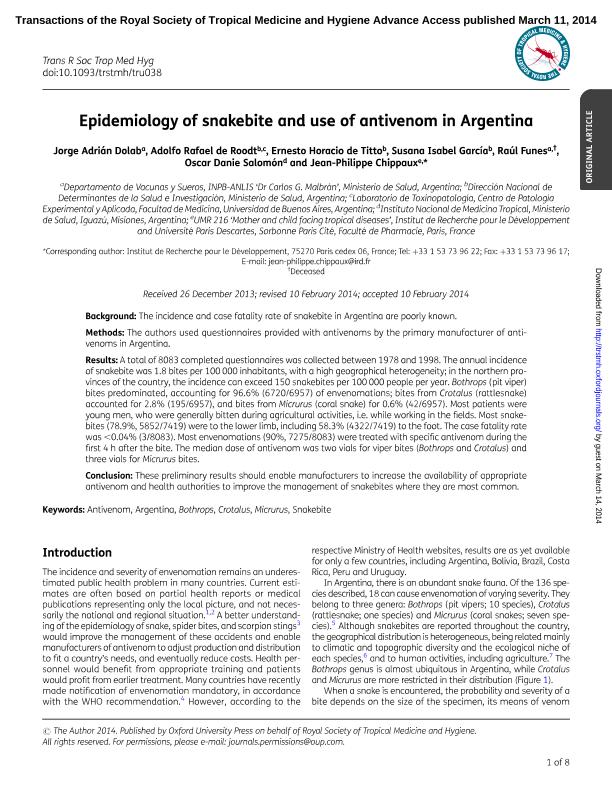Artículo
Epidemiology of snakebite and use of antivenom in Argentina
Dolab, Jorge Adrian; de Roodt, Adolfo Rafael; de Titto, Ernesto Horacio ; García, Susana Isabel; Funes, Raúl; Salomón, Oscar Daniel
; García, Susana Isabel; Funes, Raúl; Salomón, Oscar Daniel ; Chippaux, Jean Philippe
; Chippaux, Jean Philippe
 ; García, Susana Isabel; Funes, Raúl; Salomón, Oscar Daniel
; García, Susana Isabel; Funes, Raúl; Salomón, Oscar Daniel ; Chippaux, Jean Philippe
; Chippaux, Jean Philippe
Fecha de publicación:
03/2014
Editorial:
Oxford University Press
Revista:
Transactions of the Royal Society of Tropical Medicine and Hygiene
ISSN:
0035-9203
e-ISSN:
1878-3503
Idioma:
Inglés
Tipo de recurso:
Artículo publicado
Clasificación temática:
Resumen
A total of 8083 completed questionnaires was collected between 1978 and 1998. The annual incidence of snakebite was 1.8 bites per 100 000 inhabitants, with a high geographical heterogeneity; in the northern provinces of the country, the incidence can exceed 150 snakebites per 100 000 people per year. Bothrops (pit viper) bites predominated, accounting for 96.6% (6720/6957) of envenomations, bites from Crotalus (rattlesnake) accounted for 2.8% (195/6957), and bites from Micrurus (coral snake) for 0.6% (42/6957). Most patients were young men, who were generally bitten during agricultural activities, i.e. while working in the fields. Most snakebites (78.9%, 5852/7419) were to the lower limb, including 58.3% (4322/7419) to the foot. The case fatality rate was <0.04% (3/8083). Most envenomations (90%, 7275/8083) were treated with specific antivenom during the first 4 h after the bite. The median dose of antivenom was two vials for viper bites (Bothrops and Crotalus) and three vials for Micrurus bites.
Conclusion
These preliminary results should enable manufacturers to increase the availability of appropriate antivenom and health authorities to improve the management of snakebites where they are most common.
Palabras clave:
Antivenom
,
Argentina
,
Bothrops
,
Crotalus
,
Micrurus
,
Snakebite
Archivos asociados
Licencia
Identificadores
Colecciones
Articulos(CCT - NORDESTE)
Articulos de CTRO.CIENTIFICO TECNOL.CONICET - NORDESTE
Articulos de CTRO.CIENTIFICO TECNOL.CONICET - NORDESTE
Citación
Dolab, Jorge Adrian; de Roodt, Adolfo Rafael; de Titto, Ernesto Horacio; García, Susana Isabel; Funes, Raúl; et al.; Epidemiology of snakebite and use of antivenom in Argentina; Oxford University Press; Transactions of the Royal Society of Tropical Medicine and Hygiene; 108; 5; 3-2014; 269-276
Compartir
Altmétricas



